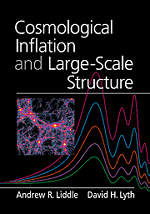Book contents
- Frontmatter
- Contents
- Frequently used symbols
- Preface
- 1 INTRODUCTION
- 2 THE HOT BIG BANG COSMOLOGY
- 3 INFLATION
- 4 SIMPLEST MODEL FOR THE ORIGIN OF STRUCTURE I
- 5 SIMPLEST MODEL FOR THE ORIGIN OF STRUCTURE II
- 6 EXTENSIONS TO THE SIMPLEST MODEL
- 7 SCALAR FIELDS AND THE VACUUM FLUCTUATION
- 8 BUILDING AND TESTING MODELS OF INFLATION
- 9 THE COSMIC MICROWAVE BACKGROUND
- 10 GALAXY MOTIONS AND CLUSTERING
- 11 THE QUASI-LINEAR REGIME
- 12 PUTTING OBSERVATIONS TOGETHER
- 13 OUTLOOK FOR THE FUTURE
- 14 ADVANCED TOPIC: COSMOLOGICAL PERTURBATION THEORY
- 15 ADVANCED TOPIC: DIFFUSION AND FREESTREAMING
- Appendix: Constants and parameters
- Numerical solutions and hints for selected examples
- References
- Index
12 - PUTTING OBSERVATIONS TOGETHER
Published online by Cambridge University Press: 05 June 2012
- Frontmatter
- Contents
- Frequently used symbols
- Preface
- 1 INTRODUCTION
- 2 THE HOT BIG BANG COSMOLOGY
- 3 INFLATION
- 4 SIMPLEST MODEL FOR THE ORIGIN OF STRUCTURE I
- 5 SIMPLEST MODEL FOR THE ORIGIN OF STRUCTURE II
- 6 EXTENSIONS TO THE SIMPLEST MODEL
- 7 SCALAR FIELDS AND THE VACUUM FLUCTUATION
- 8 BUILDING AND TESTING MODELS OF INFLATION
- 9 THE COSMIC MICROWAVE BACKGROUND
- 10 GALAXY MOTIONS AND CLUSTERING
- 11 THE QUASI-LINEAR REGIME
- 12 PUTTING OBSERVATIONS TOGETHER
- 13 OUTLOOK FOR THE FUTURE
- 14 ADVANCED TOPIC: COSMOLOGICAL PERTURBATION THEORY
- 15 ADVANCED TOPIC: DIFFUSION AND FREESTREAMING
- Appendix: Constants and parameters
- Numerical solutions and hints for selected examples
- References
- Index
Summary
In this chapter, we put together a set of observations presently available to us (i.e., in 1999), which can be interpreted using the linear and quasi-linear approaches that we have described. At present, no single type of observation is dominant in providing constraints on models of structure formation; instead, the best results come from compiling as wide a set of data as possible, covering a range of scales from our present observable Universe down to the scales of galaxies.
No doubt, the observational details will be superseded quickly, but the general approaches to using them are well established. We also give this discussion here as a post hoc motivation for the models that we considered earlier, both the inflationary aspects and the structure formation scenarios.
A detailed comparison of models with observations requires numerical investigation, to probe the nonlinear regime where many of the observations of galaxy correlations and velocities are made. However, we have seen that there remain a very significant number of undetermined parameters on which the formation of structure depends; we might consider three inflationary parameters, δH, n, and r, and several cosmological parameters such as h, Ω0, ∧, Ωb, a possible admixture of hot dark matter ΩHDM, and the redshift of reionization Zion. In all the models that we discuss, we need cold dark matter (CDM); inflation-based models do not appear to work without it. It always has whatever density is required to make the total add up correctly.
- Type
- Chapter
- Information
- Cosmological Inflation and Large-Scale Structure , pp. 301 - 313Publisher: Cambridge University PressPrint publication year: 2000



